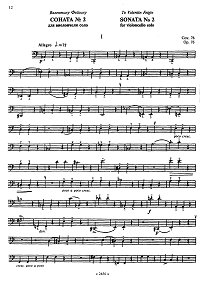Tischenko - Sonata for cello solo N2
Tischenko - Sonata for cello solo N2. You can download the PDF sheet music Tischenko - Sonata for cello solo N2 on this page. Boris Tischenko completed his Second Cello Sonata in 1979 (that is, nearly 20 years after the First Sonata). It is dedicated to Valentin Feigin. In the foreground are broad strokes and clear lines, and predominating is not cantilena, but rather vigorous rhythms and onward dynamics of melodic development. The opus has three movements, offering a tempo relationship typical for this genre (Allegro - Andante sostenuto - Presto). The middle movement is somewhat detached to contain a slow culmination of the cycle. Furthermore, each movement grows out of a brief thematic structure forming the basis of a development of an impressive scope.
To download PDF, click the "Download PDF" button below the appropriate sheet music image.
To view the first page of Tischenko - Sonata for cello solo N2 click the music sheet image. |
| PDF format sheet music |
|
|
|
Instrument part: 12 pages. 707 K
|
|
 |
|
|
|
| Download PDF (14.99
€) |
|
|
The 1st movement consists of several phases of development superseding one another. The initial phase is based on an extremely short and terse figure, which is constantly "interrupted" by a half-note stop. This rhythmic figure, very dynamic and clear, threads the entire movement with tangible pulsation. Using seemingly extremely simple tools, the composer shows remarkable ingenuity to achieve considerable rhythmic diversity and continuity of development, now due to articulation, then with the aid of metric shifts.
The advance gradually involves higher and higher registers, getting compacted by using double notes. This is when a second phase of development starts, with more complicated rhythms, and with quavers joining in. The following phases repeat the dramatic profile of the first two ones - although in a sharper and more dynamized version. The rhythmic figure of the first phase's fourths reappears, but the tones building it are scattered over different registers. After a swift race of quavers, the culmination comes in. The initial tune sounds magnificently at three fortes, reaching into the extreme registers.
The second movement is a murky and restrained monologue opening in a theme, the melodious cordiality of which is emphasized by its strict contours and by the instrument's manly low timbre. The theme undergoes melodic transformations, and becomes a part of extended advance gradually conquering a higher and more and more strained register. After a piercing culmination, the theme is stated as a two-voice canon played in pizzicato. It slips away into silence little by little, with the entire movement finished in mysteriously sounded steps over triad tones.
The sonata's finale is built upon a melodic figure containing an acutest rhythmic contrast where two large time lengths are immediately replaced by abrupt and quick quavers. This figures basis of fifths cements the entire movement, for vertical complexes will be built upon it, with rhythmically nervous pulsation in tiny time lengths. As in the preceding movements, the dramatic profile here reminds a wave - the gradual increase of tension results in a high-register culmination, after which, separate thematic "splinters" are reunited. The advance is accelerated right away, and the movement's initial material is played in tremolo in a high register. The cello's sweeping steps are drawn together into final chords crowning the entire opus. |
|